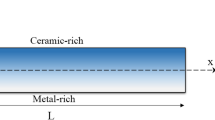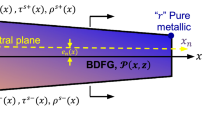Abstract
In the present work, we developed a new FEM framework to simulate the mechanical responses of the Euler–Bernoulli beam with a two-phase local/nonlocal mixed model. The shape function is a fifth-order polynomial and constitutive boundary conditions (CBCs) are treated as external loads. The main advantages of the present model are the efficient of convergence, simplicity of expressions, and the flexibility on handling various boundary conditions as well as the external loads. Several numerical tests, including static bending, free vibration, and elastic bulking, are carried out to validate the FEM framework. The results showed the complete agreement with the exact solution from Laplace transformation and indicated a simple and reliable scheme to deal with complicated nanosystems.







Similar content being viewed by others
Abbreviations
- \(\delta v, \delta v^\prime , \delta v^{\prime \prime }\) :
-
Test function and its gradient
- \({\mathbf {B}}^i\) :
-
Geometric matrix
- \({\mathbf {f}}^\mathrm {int},{\mathbf {f}}^\mathrm {ext}\) :
-
Internal and external nodal force array
- \({\mathbf {K}}^\mathrm {int}\) :
-
Jacobian matrix of the internal nodal force
- \({\mathbf {K}}_\varDelta\) :
-
Incremental stiffness matrix
- \({\mathbf {M}}\) :
-
Mass matrix
- \({\mathbf {N}}\) :
-
Shape function matrix
- \({\mathbf {u}}\) :
-
Displacement array
- \(\omega\) :
-
Frequency of vibration
- \({\overline{Q}},{\overline{M}},{\overline{T}}\) :
-
External shear force, moment, and high-order force
- \(\rho\) :
-
Density
- \(\sigma _{ij},\varepsilon _{ij}\) :
-
Components of stress and strain tensor
- \({\widehat{Q}},{\widehat{M}}\) :
-
React shear force and moment
- \(\xi ,\kappa\) :
-
Nonlocal parameters
- A :
-
The area of the cross section
- E :
-
Young’s module
- I :
-
The second axial moment of the cross-sectional area
- n :
-
External normal vector
- P :
-
Axial force
- Q, M :
-
Internal shear force and moment over cross section
- \(q,q^\prime ,q^{\prime \prime }\) :
-
Distributed pressure and its gradient
- T :
-
High-order force conjugated to the \(w^{\prime \prime }\)
- \(z,z^\prime ,z^{\prime \prime },z^{(3)},z^{(4)},z^{(5)}\) :
-
Deflection and its 1st, 2nd, 3rd, 4th, and 5th gradient with x
References
Shankar R, Ghosh TK, Spontak RJ (2007) Electroactive nanostructured polymers as tunable actuators. Adv Mater 19(17):2218–2223
Longo G, Alonso-Sarduy L, Rio LM, Bizzini A, Trampuz A, Notz J, Dietler G, Kasas S (2013) Rapid detection of bacterial resistance to antibiotics using AFM cantilevers as nanomechanical sensors. Nat Nanotechnol 8(7):522–526
Chortos A, Koleilat GI, Pfattner R, Kong D, Lin P, Nur R, Lei T, Wang H, Liu N, Lai YC et al (2016) Mechanically durable and highly stretchable transistors employing carbon nanotube semiconductor and electrodes. Adv Mater 28(22):4441–4448
Lee BH, Moon DI, Jang H, Kim CH, Seol ML, Choi JM, Lee DI, Kim MW, Yoon JB, Choi YK (2014) A mechanical and electrical transistor structure (mets) with a sub-2 nm nanogap for effective voltage scaling. Nanoscale 6(14):7799–7804
Cheng B, Yang S, Woldu YT, Shafique S, Wang F (2020) A study on the mechanical properties of a carbon nanotube probe with a high aspect ratio. Nanotechnology 31(14):145707
Lim CW, Zhang G, Reddy JN (2015) A higher-order nonlocal elasticity and strain gradient theory and its applications in wave propagation. J Mech Phys Solids 78:298–313. https://doi.org/10.1016/j.jmps.2015.02.001
Naderi A, Behdad S, Fakher M, Hosseini-Hashemi S (2020) Vibration analysis of mass nanosensors with considering the axial-flexural coupling based on the two-phase local/nonlocal elasticity. Mech Syst Signal Process. https://doi.org/10.1016/j.ymssp.2020.106931
Tian X, Sladek J, Sladek V, Deng Q, Li Q (2021) A collocation mixed finite element method for the analysis of flexoelectric solids. International Journal of Solids and Structures 217:27–39
Sladek J, Sladek V, Hosseini SM (2021) Analysis of a curved timoshenko nano-beam with flexoelectricity. Acta Mechanica 232(4):1563–1581
Eringen AC (1972) Linear theory of nonlocal elasticity and dispersion of plane waves. Int J Eng Sci 10(5):425–435
Eringen AC, Edelen D (1972) On nonlocal elasticity. Int J Eng Sci 10(3):233–248
Eringen AC (1983) On differential equations of nonlocal elasticity and solutions of screw dislocation and surface waves. J Appl Phys 54(9):4703–4710
Zhang P, Qing H (2021) Closed-form solution in bi-Helmholtz kernel based two-phase nonlocal integral models for functionally graded Timoshenko beams. Compos Struct 265:113770
Tuna M, Kirca M (2017) Bending, buckling and free vibration analysis of Euler-Bernoulli nanobeams using Eringen’s nonlocal integral model via finite element method. Compos Struct 179:269–284
Romano G, Barretta R (2017) Stress-driven versus strain-driven nonlocal integral model for elastic nano-beams. Compos Part B Eng 114:184–188
Barretta R, Marotti de Sciarra F (2018) Constitutive boundary conditions for nonlocal strain gradient elastic nano-beams. Int J Eng Sci 130:187–198. https://doi.org/10.1016/j.ijengsci.2018.05.009
Ghosh S, Sundararaghavan V, Waas AM (2014) Construction of multi-dimensional isotropic Kernels for nonlocal elasticity based on phonon dispersion data. Int J Solids Struct 51(2):392–401
Lazar M, Maugin GA, Aifantis EC (2006) On a theory of nonlocal elasticity of bi-Helmholtz type and some applications. Int J Solids Struct 43(6):1404–1421
Romano G, Barretta R, Diaco M (2017) On nonlocal integral models for elastic nano-beams. Int J Mech Sci 131:490–499
Wang Y, Zhu X, Dai H (2016) Exact solutions for the static bending of Euler-Bernoulli beams using Eringen’s two-phase local/nonlocal model. AIP Adv 6(8):085114
Wang Y, Huang K, Zhu X, Lou Z (2019) Exact solutions for the bending of Timoshenko beams using Eringen’s two-phase nonlocal model. Math Mech Solids 24(3):559–572
Zhang P, Qing H, Gao C (2019) Theoretical analysis for static bending of circular Euler-Bernoulli beam using local and Eringen’s nonlocal integral mixed model. J Appl Math Mech Zeitschrift für Angewandte Mathematik und Mechanik 99(8):e201800329
Zhang P, Qing H, Gao CF (2020) Analytical solutions of static bending of curved Timoshenko microbeams using Eringen’s two-phase local/nonlocal integral model. J Appl Math Mech Zeitschrift für Angewandte Mathematik und Mechanik 100(7):e201900207
Fernández-Sáez J, Zaera R (2017) Vibrations of Bernoulli-Euler beams using the two-phase nonlocal elasticity theory. Int J Eng Sci 119:232–248
Zhu X, Wang Y, Dai HH (2017) Buckling analysis of Euler-Bernoulli beams using Eringen’s two-phase nonlocal model. Int J Eng Sci 116:130–140
Khaniki HB (2018) Vibration analysis of rotating nanobeam systems using Eringen’s two-phase local/nonlocal model. Phys E Low Dimens Syst Nanostruct 99:310–319
Naderi A, Fakher M, Hosseini-Hashemi S (2021) On the local/nonlocal piezoelectric nanobeams: vibration, buckling, and energy harvesting. Mech Syst Signal Process 151:107432. https://doi.org/10.1016/j.ymssp.2020.107432
Farajpour A, Howard CQ, Robertson WS (2020) On size-dependent mechanics of nanoplates. Int J Eng Sci 156:103368. https://doi.org/10.1016/j.ijengsci.2020.103368
Fakher M, Hosseini-Hashemi S (2020) Nonlinear vibration analysis of two-phase local/nonlocal nanobeams with size-dependent nonlinearity by using Galerkin method. J Vib Control 27:378–391
Sahmani S, Fattahi A, Ahmed N (2019) Analytical treatment on the nonlocal strain gradient vibrational response of postbuckled functionally graded porous micro-/nanoplates reinforced with gpl. Eng Comput 36:1–20
Wang X, Zhou G et al (2021) Static and free vibration analysis of thin arbitrary-shaped triangular plates under various boundary and internal supports. Thin Walled Struct 162:107592
Bathe KJ (2006) Finite element procedures. Klaus-Jurgen Bathe, Berlin
Zienkiewicz OC, Taylor RL (2005) The finite element method for solid and structural mechanics. Elsevier, Amsterdam
Norouzzadeh A, Ansari R (2017) Finite element analysis of nano-scale Timoshenko beams using the integral model of nonlocal elasticity. Phys E Low Dimens Syst Nanostruct 88:194–200
Eptaimeros K, Koutsoumaris CC, Tsamasphyros G (2016) Nonlocal integral approach to the dynamical response of nanobeams. Int J Mech Sci 115:68–80
Taghizadeh M, Ovesy H, Ghannadpour S (2016) Beam buckling analysis by nonlocal integral elasticity finite element method. Int J Struct Stab Dyn 16(06):1550015
Merzouki T, Houari MSA, Haboussi M, Bessaim A, Ganapathi M (2020) Nonlocal strain gradient finite element analysis of nanobeams using two-variable trigonometric shear deformation theory. Eng Comput 1–19
Phung-Van P, Thai CH (2021) A novel size-dependent nonlocal strain gradient isogeometric model for functionally graded carbon nanotube-reinforced composite nanoplates. Eng Comput 1–14
Pradhan S (2012) Nonlocal finite element analysis and small scale effects of CNTS with Timoshenko beam theory. Finite Elements Anal Des 50:8–20
Phadikar J, Pradhan S (2010) Variational formulation and finite element analysis for nonlocal elastic nanobeams and nanoplates. Comput Mater Sci 49(3):492–499
Tran VK, Pham QH, Nguyen-Thoi T (2020) A finite element formulation using four-unknown incorporating nonlocal theory for bending and free vibration analysis of functionally graded nanoplates resting on elastic medium foundations. Eng Comput 1–26
Thai HT, Vo TP (2012) A nonlocal sinusoidal shear deformation beam theory with application to bending, buckling, and vibration of nanobeams. International Journal of Engineering Science 54:58–66
Safeer M, Khadimallah MA, Taj M, Hussain M, Elaloui E, Touns A (2021) Strength performance with buckling analysis of intermediate filaments by consideration nonlocal parameters. Computers and Concrete 28(1):69–75
Van Vinh P (2022) Nonlocal free vibration characteristics of power-law and sigmoid functionally graded nanoplates considering variable nonlocal parameter. Physica E: Low-dimensional Systems and Nanostructures135:114951
Hoa LK, Vinh PV, Duc ND, Trung NT, Son LT, Thom DV (2020) Bending and free vibration analyses of functionally graded material nanoplates via a novel nonlocal single variable shear deformation plate theory. Proceedings of the Institution of Mechanical Engineers, Part C: Journal of Mechanical Engineering Science p 0954406220964522
Daikh AA, Drai A, Bensaid I, Houari MSA, Tounsi A (2021) On vibration of functionally graded sandwich nanoplates in the thermal environment. Journal of Sandwich Structures & Materials 23(6):2217–2244
Pisano A, Sofi A, Fuschi P (2009) Nonlocal integral elasticity: 2d finite element based solutions. Int J Solids Struct 46(21):3836–3849
Fakher M, Hosseini-Hashemi S (2020) Vibration of two-phase local/nonlocal Timoshenko nanobeams with an efficient shear-locking-free finite-element model and exact solution. Eng Comput 1–15
Eringen AC (1984) Theory of nonlocal elasticity and some applications. Princeton University NJ Department of Civil Engineering, Technical report
Acknowledgements
The authors are grateful for the support of the present work by the National Natural Science Foundation of China (12172169) and the Priority Academic Program Development of Jiangsu Higher Education Institutions. Bian is also grateful for the scholarship provided by the China Scholarship Council for a 1-year study at the University of Stuttgart (201806830018).
Author information
Authors and Affiliations
Corresponding author
Additional information
Publisher's Note
Springer Nature remains neutral with regard to jurisdictional claims in published maps and institutional affiliations.
Appendices
A List of the terms in the weak form of the present model
Some terms in the the weak form of the present model from the theorem of divergence (integration by parts for one-dimension case) are listed here:
B Shape and geometric matrices of the present beam element
The explicit expression of the shape function and the ith geometric matrix of the fifth-order polynomial are listed (over the internal \([0,l_\mathrm {e}]\)):
C Table of coefficients of CBCs at both sides of the beam
D Table of locations and weights with Gaussian quadrature
Some low-order quadrature rules are tabulated below (over interval \([-1,1]\)) (Table 2).
where 7-points quadrature is only necessary for calculating \(\int _V{\mathbf {N}}^\mathrm {T}{\mathbf {N}}\mathrm {d}V\)
E Lagrange multiplier method for linear constrain in FEM
The solution of the differential equation with constraints is equivalent to finding the stationary points of the stationary points of :
The value of \(\lambda _I\) is the react-force or moment at boundaries.
F Derivation of the exact solution to free vibration analysis of the present nonlocal Euler–Bernoulli beam with Laplace transform
Ignoring the axial force P and performing Laplace transformation on Eq. (5) , one gets
Applying the Laplace transformation to both sides of Eq. (7) and taking into account the convolution theorem, one can derive
where
According to the derivative property on Laplace transformation, one can obtain
in which
Combining Eqs. (57), (58), and (60), and taking into account
where
The parameters \(a_0\), p and q are listed as follows:
One obtains Eq. (62)
For the nonlocal beam with clamped–clamped boundary conditions, we can obtain from Eq. (62) and Eq. (65)
where \(L_i(x),\ i=0,1,\ldots ,5\) are defined as
Combining the Eqs. (59) and (66) as well as clamped boundary at the both sides of the beam, we can obtain
where \(A_{ij}^\mathrm {CC}\) are listed as follows:
None-zero solution of homogeneous linear Eq. (68) requires the coefficient matrix of \(C_0\), \(C_1\), and \(C_2\) singular, e.g.,
The eigenvalues \(\omega\) can be thus obtained numerically.
Rights and permissions
About this article
Cite this article
Bian, PL., Qing, H. Structural analysis of nonlocal nanobeam via FEM using equivalent nonlocal differential model. Engineering with Computers 39, 2565–2581 (2023). https://doi.org/10.1007/s00366-021-01575-5
Received:
Accepted:
Published:
Issue Date:
DOI: https://doi.org/10.1007/s00366-021-01575-5




